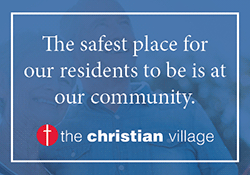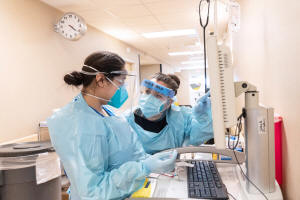Texas doctors in rural hotspots left out in cold on vaccine
 Send a link to a friend
Send a link to a friend
 [December 18, 2020]
By Brad Brooks [December 18, 2020]
By Brad Brooks
LAMESA, Texas (Reuters) - Running in
between patients, Dr. Eileen Sprys pauses to catch her breath, tries to
gather herself, but cannot mask her frustration: The health care workers
in her COVID-besieged West Texas hospital were left out of the first
shipment of the Pfizer and BioNTech vaccine, and they have no idea when
they may get it.
Not a single rural hospital in this state that prides itself on its
country roots received any doses of the vaccine this week, despite such
medical outposts serving around 20% of the state's population, or 3
million people.
Even before the pandemic, rural hospitals in Texas and many other states
were operating on "skin and bones" staffing and budgets, Sprys said.
"We're all exposed all the time," she said. "We don't have an isolated
COVID wing or staff only dedicated to COVID unlike in larger hospitals.
To not be included in the first shipment of vaccines is just so
upsetting."
This isn't the first sign of inequality in the pandemic. Rural and urban
poor residents across the U.S. have lamented not receiving treatments
and medications as the better off, nor the quantity or quality of
testing.

Sprys, her three fellow doctors and the 28 members of the nursing staff
at the Medical Arts Hospital in Lamesa have been looking forward to the
vaccine for months, hoping it would bring relief to Dawson County.
One of the poorest counties in Texas, nearly a quarter of Dawson's
13,000 residents live in poverty. To date, it has seen 1,325 coronavirus
cases and 42 deaths, according to the state health department's count.
Rural hospitals around the nation, and particularly in Texas, have faces
widespread closures after years of budget cuts. Some 27 rural hospitals
have closed in Texas in the past decade - double that of any other
state.
If it weren't for a $10 billion federal stimulus aimed at rural
hospitals nationwide in May, another half dozen small Texas facilities
would have closed, estimated John Henderson, the president of the Texas
Organization of Rural and Community Hospitals.
NEEDLES IN ARMS
The Texas Department of State Health Services is tasked with allocating
where the vaccine goes. A 17-person expert panel is charged with
delivering recommendations on allotments to the state's health
commissioner, Dr. John Hellerstedt, who has the final say on deliveries.
In a Dec. 14 letter sent to rural health advocates, Hellerstedt praised
their patience and wrote that a "more inclusive" strategy of who gets
vaccines will begin next week and that the pending approval of the
Moderna vaccine would help alleviate rural shortfalls.
Chris Van Deusen, a spokesman for state health services, said there were
two big reasons why rural areas were left off the initial Pfizer vaccine
shipments. The first is that the smallest shipment contains 975 doses,
so the state sent it to hospitals who said they had that many health
care workers to inoculate.
The second reason is that the Pfizer vaccine needs to be stored in
special freezers, which larger facilities were more likely to have. But
that reasoning irks the doctors in Lamesa as their hospital had
purchased one of those freezers in anticipation.
[to top of second column]
|

Healthcare workers Leticia Lascano and Stephanie Carden (L) wear
personal protective equipments as they discuss about a patient at
Medical Arts Hospital in Lamesa, Texas, U.S., December 17, 2020.
REUTERS/Go Nakamura

The Moderna vaccine, Van Deusen said, is easier to store and will be
able to be shipped with a minimum of 100 doses, meaning it can go to
smaller hospitals.
Time is of the essence, said Henderson, of the Texas Organization of
Rural and Community Hospitals.
"You have one doctor out because of coronavirus in a small town, and
that may mean you just lost half of your medical staff," he said.
Henderson said the state should embrace alternatives - such as
having regional medical centers not vaccinate lower-risk staff, and
instead earmark some doses for the frontline rural doctors and
nurses.
'ANSWERING THE CALL'
It's difficult to recruit doctors to work in any small town, and
those that do are considered the crown jewels of their communities.
Many residents interviewed in Lamesa said they were adamant that
their medical staff should be protected immediately.
Debbie Aylesworth, 67, credits Sprys and the staff at the Lamesa
hospital with keeping her off a ventilator when she had COVID-19 a
few months ago. After Aylesworth was exposed to the virus in
October, Sprys texted her daily to ask if she was having any
symptoms.
If not for Sprys' insistence, Aylesworth said she likely would have
delayed seeking treatment and ended up being far worse off.
"Those doctors are answering the call," she said. "They are dealing
with the worst of what this pandemic is dishing out, so they should
be seeing the benefit of the vaccine."
Josh Stevens, the mayor of Lamesa, said the area has been as
brutalized by the pandemic as anywhere else in Texas.
Making matters worse, he said, is that about 85% of the town's
population is considered part of the essential work force - most
working in agriculture along with oil and gas - meaning more of
Lamesa's citizens have been out on the frontlines.

"Most people in Lamesa have had nowhere to hide from this virus, and
our doctors have had to deal with that reality," he said. "Them not
being at the front of the line to get a vaccine is a slap in the
face for all of rural Texas."
(Reporting by Brad Brooks; Editing by Aurora Ellis)
[© 2020 Thomson Reuters. All rights
reserved.] Copyright 2020 Reuters. All rights reserved. This material may not be published,
broadcast, rewritten or redistributed.
Thompson Reuters is solely responsible for this content. |